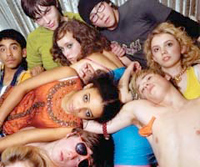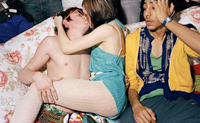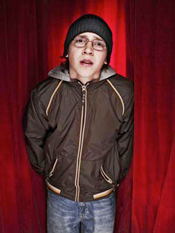Kid’s Today! Skins: The Wild Bunch
To the horror of parents and the delight of just about everyone else, the TV drama Skins blew the lid off what untamed teenagers get up to when let off the leash. With the second series due, Cassandra Jardine went behind the scenes to meet the show’s surprisingly sensible cast and its frighteningly young writers. If you don’t want to know the score, look away now… (Jardine, 2008)

This standfirst (an introduction to an article situated beneath the headline in newspapers) sums up the contradictions that surround Skins (Company Pictures for E4, 2007-).
On the one hand it shows what teenagers actually ‘get up to’; on the other, everyone involved, many of who are teenagers, is ‘surprisingly sensible’.
Later in the article, 19-year-old Mike Bailey, (Sid) is quoted as saying: ‘I don’t know anyone who has stolen a car and crashed into a canal…’. Hence the claims of realism are already looking rather fragile; however, parents – it seems – are all too ready to believe the hell-raising hedonism that the characters get up to is actually what their daughters and sons are doing.
Although ‘teenagers’, as a defined category, wasn’t invented until 1944, Jon Savage (2008) shows how ‘the creation of youth’ has been fraught with conflict, with older generations, since the latter part of the 19th century. Skins emphasises the ‘different worlds’ that teens and adults (appear to) live in by representing the latter as hopeless at helping their children and the former as constantly striving to solve their problems which are almost always rooted in their relationships with their peers.
This essay will focus on how genre, narrative and representation are used to create ‘emotional realism’ that successfully strikes a chord with the programme’s target audience and refers wholly to series one.
Genre

The writers of Skins, most of them youngsters under the guidance of TV veteran Bryan Elsley, describe the programme as being similar to soap opera (Jardine, 2008); however it is better considered as a teen pic.
Teen pics came into their own in late 1950s Hollywood, as young people had significant disposable income for the first time and their parents were less and less likely to go to the cinema.
As Steve Neal (2000) outlines, the teen pic comes in a number of forms, such as: the ‘social problem’ picture and exploitation movies. The ‘social problem’ pic was usually aimed at an older audience, and represented teenager behaviour as being delinquent and therefore a problem that needed solving; for example, Rebel Without A Cause (1956). The ‘exploitation’ picture, on the other hand, is specifically targeted at youth. It is colourfully defined by Wikipedia as films that:
may feature forbidden sex, wanton violence, drug use, nudity, freaks, gore, the bizarre, destruction, rebellion and mayhem.
http://en.wikipedia.org/wiki/Exploitation_films, accessed June 2008
This ‘genre’ was well exploited by Roger Corman’s American International Pictures with films such as A Bucket of Blood (1959). Skins falls comfortably into the latter category with its ‘shocking’ representation of ‘teenagers today’: for example, Chris’s need to get rid of an erection caused by Viagra and how he pisses into the air because of it (episode 4) and having sex with his teacher (5); Jal tells Michelle to ‘ring me back when you’re not actually being penetrated’ (3); Michelle vomits on a teacher (7).
Unlike many exploitation films, however, Skins does have high production values. It uses its ‘shocking’ content as a way of defining itself as ideal for E4: aimed at a younger audience and more risqué than mainstream channels.

In common with teen pics, the time scale of the programme is distinct. The first two series cover the two years of A level courses; the third series will start from scratch with a new set of characters, rather than follow the first two series’ set to university.
Teen pics, by their nature, cannot cover much time as their characters change physically more quickly than older groups; indeed it’s not uncommon for the teen pic to cover just 24 hours (for example, La Haine, France, 1995).
However Skins does lack obvious rebel characters. Tony, whilst obviously charismatic, is merely content to annoy his dad (1), however he doesn’t reject the ‘adult’ values of education; he’s so ‘cool’ he can do virtually anything and still hand work in on time. His sang froid is only challenged by Michelle’s rejection (7-9).
Rebellion, in Skins, is limited to hedonistic behaviour; politics, not even single-issue politics, are wholly absent. In the teen pic rebellion is invariably recouped by the narrative closure where the teens are seen to ‘grow up’; the ‘rites of passage’ narrative has taught them the life lesson that they can’t act like teenagers forever. This reactionary (as it suggests that teens should be inculcated into the status quo) ‘moral’ is also evident in Skins.
Although it is Sid that tells his dad to grow up (5), thereby demonstrating his growing maturity and he comes to terms with his unrequited desire for Michelle and his love for Cassandra (the whole series). Tony, after all his friends, except Sid, reject him, understands his behaviour towards others is wrong (9). Michelle decides to be nice to her step dad and encourages him to return to her mother (7).
There are elements of sitcom and soap opera in Skins too. In episode one the car, and its occupants, end up in the dock. Sid turns up at Cassie’s sanitorium the exact moment that she leaves (9) in a soap-opera like narrative coincidence; this also has sitcom-like farce as Sid is locked up as it appears he is mentally ill but his actions are due to his lovelorn behaviour. When Tony eventually gets him out, Laurel and Hardy’s ‘This is another fine mess you’ve got yourself in’ is quoted.
Narrative
Skins does have an unusual narrative structure; it is both a serial, in that episodes follow one another chronologically, and also a series, each programme is self contained. The programme focuses on one character from the ‘gang’ in each episode, and most of the rest of the gang will appear in each ‘others’ programme; the ‘focus’ character must always be onscreen unless they’ve just left or are about to arrive (the exceptions are the final episode (Everyone: 9) and ‘Effy’ (8) which cross cuts between Effy ‘on the loose’ and Tony’s search for her.
That said, episodes are more obviously self-contained series than serial; though Sid’s run-in with a drug dealer does ‘arc’ over three episodes (1-3). Typically, this rewards the loyal viewer who gets the benefit of following the ‘arc’ but doesn’t alienate the more infrequent audience who can still readily follow what’s going on.
The programme is also symptomatic of modern television in that there are ‘spin off’ narratives available on the website; it tries to engage audiences with ‘360-degree television’. The attempt is to use new media technologies to fully engage the ‘media savvy’ generation in the programme; Skins actually officially debuted on MySpace before it was shown on E4.

Like most mainstream narrative, Maxxie notwithstanding, the heterosexual union is a driving force of closure. In the final episode Chris is seen on a bended knee ‘proposing’ to Angie, the teacher. Tony tells Michelle, ‘You’re the only one. The truth is I love you.’ Sid is desperately chasing after Cassie. So amongst all the ‘shocking’ behaviour, bourgeois values hold sway.
However closure is resisted as the second series is obviously set-up, most clearly when Tony steps out in front of an on-rushing care. Whilst the narrative is clichéd it’s highly likely that it’s original to its jejune target audience.
Representation

Teenagers, who are neither children nor adults, fall awkwardly between the ‘binary oppositions’ of ‘children’ and ‘adults’.
As is often the case with groups who are not easy to categorise, teens often find themselves ‘demonised’ in media representations; because they don’t fit they are a problem. Rachel Moseley suggests:
Teenageness is a significant ‘in-between’ period, and teen drama deals with the stuff of adolescent anxiety: friendship, love, sex and impending adulthood. (Moseley, 2001, p. 42b)
Skins deals with most of these problems: relationship; parents; the demands of studying; peer group pressure and so on, but doesn’t suggest teens are the problem. Parents, on the other hand, are, at the very least, a nuisance; they are, in fact, represented as more juvenile than the teens.
The History teacher, who takes them to Russia (6), appears to base his behaviour upon Steve Coogan’s Alan Partridge such is his ‘nerdness’. Tony’s dad is constantly angry, Sid’s is little better; Anwar’s dad is disappointed by his son’s lack of religiosity. Michelle’s mum, apparently, goes through a series of unsuitable men.
Even the police and doctor in the episode eight are buffoonish. Part of the teens’ problems is dealing with adults who haven’t a clue about their lives.
In terms of social class, the teens range from middle to upper middle class. They all live financially comfortable lives, though emotional support at home is often lacking. The location is unspecific. It is shot in Bristol, but other than some regional accents – Welsh and West Country – it isn’t particularly of its place (though episode 9 does feature the spectacular Clifton suspension bridge).
The episode set in Russia (6), however, is almost surreal in its retro Cold War view of the place. It is littered with absurd stereotypes of corrupt, violent and poor people. The conclusion, where we find the Russians have been ‘playing around’ all the time ,doesn’t, in my view, alleviate the stupidity of the what’s been shown before.
As expected in a modern text aimed at a young audience, there is a diversity of characters: the ‘black’ Jal, the most studious; the Muslim, Anwar; the gay, Maxxie. These are all fully rounded characters whose behaviour is not simply motivated by their ethnicity, religion or sexual orientation.
However one of the minor characters is a straightforward ‘beat boy’ stereotype complete with ‘street talk’ and ‘gear’. The treatment of Cassandra’s anorexia (2) is subtly handled; much of this is due to Hannah Murray’s performance. Her episode dips into surrealism as she imagines ‘eat’ texts on her phone.
It’s difficult to comment on the use of music as the soundtrack used on television was not licensed for the DVD. The final episode steps into the musical genre, as characters sing along to the soundtrack about (I think) their bewilderment about the world.
Clearly this is not realism but the programme, if its 9/10 rating on the internet movie database is anything to go by, does strike a chord with its audience.
It is possible that this chord is the ‘emotional realism’ described by Ien Ang in her book on audience responses to the 1970s-80s American soap opera Dallas. She demonstrates that the realism that audiences enjoyed when watching Dallas was not situated in its representation of social reality but:
it is situated at the emotional level: what is recognized as real is not knowledge of the world, but a subjective experience of the world: ‘a structure of feeling’. (Ang, 1989, p. 45)
So it is probably best that we consider Skins to offer an emotional representation of 17-18 year olds trying forge relationships, both sexual and social, in a cosseted middle class world.
References
Ien Ang (1989, translated Della Couling) Watching Dallas: soap opera and the melodramatic imagination (Routledge: London and New York) ed. Glen Creeber (2001) The Television Genre Book (British film institute: London)
Cassandra Jardine (2008) ‘Skins – the wild bunch’, 31 January, [url=http://www.telegraph.co.uk/arts/main.jhtml?xml=/arts/2008/02/02/sm_skins02.xml]http://www.telegraph.co.uk/arts/main.jhtml?xml=/arts/2008/02/02/sm_skins02.xml[/url], accessed June 2008
Rachel Moseley (2001) ‘The Teen Series’ in ed. Creeber
Steve Neale (2000) Genre and Hollywood (Routledge: London and New York)
Jon Savage (2008) Teenage: The Creation of Youth 1875-1945 (Pimlico: London)
Roy Stafford (2004) Youth Pictures (In The Picture Publications, 36 Hospital Road, Riddlesden, Keighley, West Yorks BD20 5EU)